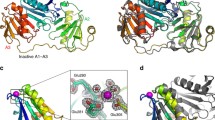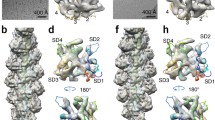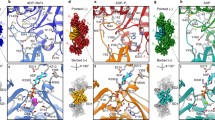Abstract
Calponin homology domains link many different proteins to the surface of actin filaments. However, details of the structural interactions involved and the methods used to determine them are controversial. In the case of the actin-binding protein utrophin, for example, several models have been proposed for the binding of utrophin's calponin homology domains to actin. We review and evaluate these models and their supporting data.
Similar content being viewed by others
References
Ayscough KR (1998) In vivo functions of actin-binding proteins. Curr Opin Cell Biol 10: 102–111.
Baker TS and Johnson JE (1996) Low resolution meets high: towards a resolution continuum from cells to atoms. Curr Opin Struct Biol 6: 585–594.
Bashour A-M, Fullerton AT, Hart MJ and Bloom GS (1997) IQGAP1, a Rac-and Cdc42-binding protein, directly binds and cross-links microfilaments. J Cell Biol 137: 1555–1566.
Bretscher A and Weber K (1980) Fimbrin, a new microfilamentassociated protein present in microvilli and other cell surface structures. J Cell Biol 86: 335–340.
Castresana J and Saraste M(1995) Does Vav bind to F-actin through a CH domain? FEBS Lett 374: 149–151.
Djinovic-Carugo K, Gautel M, Ylanne J and Young P (2002) The spectrin repeat: a structural platform for cytoskeletal protein assemblies. FEBS Lett 513: 119–123.
Egelman EH (2000) A robust algorithm for the reconstruction of helical filaments using single-particle methods. Ultramicroscopy 85: 225–234.
Galkin VE, Orlova A, Lukoyanova N, Wriggers W and Egelman EH (2001) Actin depolymerizing factor stabilizes an existing state of Factin and can change the tilt of F-actin subunits. J Cell Biol 153: 75–86.
Galkin VE, Orlova A, VanLoock MS and Egelman EH (2003) Do the utrophin tandem calponin homology domains bind F-actin in a compact or extended conformation? J Mol Biol 331: 967–972.
Galkin VE, Orlova A, VanLoock MS, Rybakova IN, Ervasti JM and Egelman EH (2002) The utrophin actin-binding domain binds Factin in two different modes: implications for the spectrin superfamily of proteins. J Cell Biol 157: 243–251.
Garcia-Alvarez B, Bobkov A, Sonnenberg A and de Pereda JM (2003) Structural and functional analysis of the actin binding domain of plectin suggests alternative mechanisms for binding to F-actin and integrin beta4. Structure (Camb) 11: 615–625.
Gillis J-M (2000) An attempt of gene therapy in Duchenne muscular dystrophy: overexpression of utrophin in transgenic mdx mice. Acta Neurol Belg 100: 146–200.
Gimona M, Djinovic-Carugo K, Kranewitter WJ and Winder SJ (2002) Functional plasticity of CH domains. FEBS Lett 513: 98–106.
Goldsmith SC, Pokala N, Shen W, Fedorov AA, Matsudaira P and Almo SC (1997) The structure of an actin-crosslinking domain from human fimbrin. Nature Struct Biol 4: 708–712.
Goodman A, Goode BL, Matsudaira P and Fink GR (2003) The Saccharomyces cerevisiae calponin/transgelin homolog Scp1 functions with fimbrin to regulate stability and organization of the actin cytoskeleton. Mol Biol Cell 2003 14: 2617–2629.
Hanein D, Matsudaira P and DeRosier DJ (1997) Evidence for a conformational change in actin induced by fimbrin (N375) binding. J Cell Biol 139: 387–396.
Hanein D, Volkmann N, Goldsmith S, Michon AM, Lehman W, Craig R, DeRosier D, Almo S and Matsudaira P (1998) An atomic model of fimbrin binding to F-actin and its implications for filament crosslinking and regulation. Nature Struct Biol 5: 787–792.
Hodgkinson JL, El-Mezgueldi M, Craig R, Vibert P, Marston SB and Lehman W (1997) 3-D image reconstruction of reconstituted smooth muscle thin filaments containing calponin: visualization of interactions between F-actin and calponin. J Mol Biol 273: 150–159.
Huang CC, Couch GS, Pettersen EF and Ferrin TE (1996) Chimera: An Extensible Molecular Modeling Application Constructed Using Standard Components. Pacific Symposium on Biocomputing 1: 724 See http://www.cgl.ucsf.edu/chimera.
Humphrey W, Dalke A and Shulten K (1996) VMD: visual molecular dynamics. J Mol Graph 14: 33–38.
Keep NH (2000) Structural comparison of actin binding in utrophin & dystrophin. Neurol Sci 21: S929–S937.
Keep NH, Winder SJ, Moores CA, Walke S, Norwood FLM and Kendrick-Jones J (1999) Crystal structure of the actin-binding region of utrophin reveals a head-to-tail dimer. Structure 7: 1539–1546.
Klein MG, Shi W and Almo SC (2001) Crystal structure of the functional cross-linking core of fimbrin from Arabidopsis thalanania. Mol Biol Cell 12: 155a.
Knight P and Trinick J (1984) Structure of the myosin projections on native thick filaments from vertebrate skeletal muscle. J Mol Biol 177: 461–482.
Lawson D, Harrison M and Shapland C (1997) Fibroblast transgelin and smooth muscle SM22a are the same protein, the expression of which is down-regulated in many cell lines. Cell Motility Cytoskel 38: 250–257.
Lees-Millar JP, Heeley DH, Smillie LB and Kay CM (1987) Isolation and characterization of an abundant and novel 22 kDa protein (SM22a) from chicken gizzard smooth muscle. J Biol Chem 262: 2988–2993.
Lehman W (1991) Calponin and the composition of smooth muscle thin filaments. J Muscle Res Cell Motility 12: 221–224.
Lehman W, Craig R, Tobacman LS and Xu C (2004) Defining the positions of tropomyosin on thin filaments in the relaxed state by EM and 3D reconstruction. Biophys J 86: 19a.
Liu Y and Eisenberg D (2002) 3D domain swapping: as domains continue to swap. Protein Sci 11: 1285–1299.
Lorenz M, Popp D and Holmes KC (1993) Refinement of the F-actin model against X-ray fiber diffraction data by use of a directed mutation algorithm. J Mol Biol 234: 826–836.
McGough A, Way M and DeRosier D (1994) Determination of the aactinin binding site on actin filaments by cryoelectron microscopy and image analysis. J Cell Biol 126: 433–443.
Menice CB, Hulvershorn J, Adam LP, Wang C-LA and Morgan KG (1997) Calponin and mitogen-activated protein kinase signaling in differentiated vascular smooth muscle. J Biol Chem 272: 25157–25161.
Moody C, Lehman W, and Craig R (1990) Caldesmon and the structure of vertebrate smooth muscle thin filaments: Electron microscopy of isolated thin filaments. J Muscle Res Cell Motility 11: 176–185.
Moores CA, Keep NH and Kendrick-Jones J (2000) Structure of the utrophin actin-binding domain bound to F-actin reveals binding by an induced fit mechanism. J Mol Biol 297: 465–480.
Moores CA and Kendrick-Jones J (2000) Biochemical characterisation of the actin-binding properties of utrophin. J Cell Motility Cytoskeleton 46: 116–128.
Mu XQ, Egelman EH and Bullitt E (2002) Structure and function of Hib pili from Haemophilus influenzae type b. J Bacteriol 184: 4868–4874.
Narita A, Yasunaga T, Ishikawa T, Mayanagi K and Wakabayashi T (2001) Ca2+-induced switching of troponin and tropomyosin on actin filaments as revealed by electron cryo-microscopy. J Mol Biol: 241–261.
Norwood FLM, Sutherland-Smith AJ, Keep NH and Kendrick-Jones J (2000) The structure of the N-terminal actin-binding domain of human dystrophin and how mutations in this domain may cause Duchenne or Becker muscular dystrophy Structure 8: 481–491.
Orlova A and Egelman EH (1995) Structural dynamics of F-actin: 1. Changes in the C-terminus. J Mol Biol 245: 582–597.
Pollard TD and Earnshaw WC (2002) Cell Biology pp. 566–567, Saunders, Philadelphia.
Rayment I, Holden HM, Whittaker M, Yohn CB, Lorenz M, Holmes KC and Milligan RA (1993) Structure of the actin-myosin complex and its implications for muscle contraction. Science 261: 58–65.
Rost LE, Hanein D and DeRosier DJ (1998) Reconstruction of symmetry deviations: a procedure to analyze partially decorated Factin and other incomplete structures. Ultramicroscopy 72: 187–197.
Rybakova IN, Patel JR, Davies KE, Yurchenco PD and Ervasti JM (2002) Utrophin binds laterally along actin filaments and can couple costameric actin with sarcolemma when overexpressed in dystrophin-deficient muscle. Mol. Biol Cell 13: 1512–1521.
Saibil H (2000) Conformational changes studied by cryo-electron microscopy. Nature Struct Biol 7: 918–926.
Stewart M (1988) Computer image processing of electron micrographs of biological structures with helical symmetry J Electron Microscopy Techniques 9: 325–358.
Sutherland-Smith AJ, Moores CA, Norwood FLM, Hatch V, Craig R, Kendrick-Jones J and Lehman W(2003) An atomic model for actin binding by the CH domains and spectrin-repeat modules of utrophin and dystrophin. J Mol Biol 329: 15–33.
Tacitus GC (circa 110 AD) Annals 1:47 (quote meaning ''Viewed from a distance, everything is beautiful.'')
Trinick J and Elliott AJ (1982) Effect of substrate on freeze-dried and shadowed protein structures. J Microsc 126: 151–156.
Volkmann N, Ouyang G, Trybus KM, DeRosier DJ, Lowey S and Hanein D (2003). Myosin isoforms show unique conformations in the actin-bound state. Proc Natl Acad Sci USA 100: 3227–3232.
Walker ML, Burgess SA, Sellers JR, Wang F, Hammer JA 3rd, Trinick J and Knight PJ (2000) Two-headed binding of a processive myosin to F-actin. Nature 405: 804–807.
Way M, Pope B, Cross RA, Kendrick-Jones J and Weeds AG (1992) Expression of the N-terminal domain of dystrophin in E. coli and demonstration of binding to F-actin. FEBS Lett 301: 243–245.
Winder SJ, Hemmings L, Maciver SK, Bolton SJ, Tinsley JM, Davies KE, Critchley DR and Kendrick-Jones J (1995) Utrophin actin binding domain: analysis of actin binding and cellular targeting. J Cell Sci 108: 63–71.
Author information
Authors and Affiliations
Rights and permissions
About this article
Cite this article
Lehman, W., Craig, R., Kendrick-Jones, J. et al. An open or closed case for the conformation of calponin homology domains on F-actin?. J Muscle Res Cell Motil 25, 351–358 (2004). https://doi.org/10.1007/s10974-004-0690-7
Issue Date:
DOI: https://doi.org/10.1007/s10974-004-0690-7




